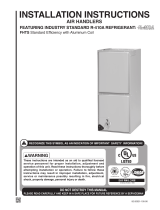
USER’S INFORMATION MANUAL
UPFLOW, DOWNFLOW, UPFLOW/HORIZONTAL & HORIZONTAL
ONLY INDUCED DRAFT GAS FURNACES
R
ecognize this symbol as an indication of Important Safety Information!
!
— Do not store or use gasoline or other
flammable vapors and liquids, or other
combustible materials in the vicinity of
this or any other appliance.
— WHAT TO DO IF YOU SMELL GAS
• Do not try to light any appliance.
• Do not touch any electrical switch;
do not use any phone in your
building.
• Immediately call your gas supplier
from a neighbor’s phone. Follow the
gas supplier’s instructions.
• If you cannot reach your gas
supplier, call the fire department.
• Do not rely on smell alone to detect
leaks. Due to various factors, you may
not be able to smell fuel gases.
• A U. L. recognized fuel gas and CO
detector(s) are recommended in all
applications, and their installation should
be in accordance with the
manufacturer’s recommendations and/or
local laws, rules, regulations or codes.
— Installation and service must be
performed by a qualified installer,
service agency or the gas supplier.
If the information in this manual is not followed exactly,
a fire or explosion may result, causing property
damage, personal injury or loss of life.
WARNING
!
92-20802-114-00
DO NOT DESTROY. PLEASE READ CAREFULLY AND KEEP IN A SAFE PLACE FOR FUTURE REFERENCE.
FOR YOUR SAFETY
!
IMPORTANT: READ THESE
INSTRUCTIONS THOROUGHLY
BEFORE ATTEMPTING TO OPERATE
THIS FURNACE.
This furnace has been designed to
give you many years of efficient,
dependable home comfort. With
regular maintenance, this furnace will
operate satisfactorily year after year.
Please read this manual to familiarize
yourself with operation, routine
maintenance schedule, and safety
procedures.
DEVICES ATTACHED TO THE FLUE
OR VENT FOR THE PURPOSE OF
REDUCING HEAT LOSS UP THE
CHIMNEY, INCLUDING FIELD-
INSTALLED DRAFT INDUCERS,
HAVE NOT BEEN TESTED AND
HAVE NOT BEEN INCLUDED IN THE
DESIGN CERTIFICATION OF THIS
FURNACE. WE, THE MANUFAC-
TURER, CANNOT AND WILL NOT BE
RESPONSIBLE FOR INJURY OR
DAMAGE CAUSED BY THE USE OF
SUCH UNTESTED AND/OR
UNCERTIFIED DEVICES,
ACCESSORIES OR COMPONENTS.
SAFETY
IMPROPER INSTALLATION,
ADJUSTMENT, ALTERATION,
SERVICE OR MAINTENANCE CAN
CAUSE PROPERTY DAMAGE,
PERSONAL INJURY OR DEATH.
FOR ASSISTANCE OR ADDITIONAL
INFORMATION CONSULT A
QUALIFIED INSTALLER, SERVICE
AGENCY OR THE GAS SUPPLIER.
OBSTRUCTION OF THE AIR VENT
ON AN LP (PROPANE) TANK
REGULATOR CAN CAUSE
EXPLOSION OR FIRE RESULTING IN
PROPERTY DAMAGE, SEVERE
PERSONAL INJURY OR DEATH.
YOUR GAS SUPPLIER SHOULD
PERIODICALLY INSPECT AND
CLEAN THE AIR VENT SCREEN TO
PREVENT ANY OBSTRUCTION.
KEEP PROTECTIVE REGULATOR
COVER IN PLACE, AS EXPOSURE
TO THE ELEMENTS CAN CAUSE
ICE BUILDUP AND REGULATOR
FAILURE.
CAREFULLY FOLLOW THESE
SAFETY RULES:
1. Combustible material must not be
placed on or against the furnace
jacket. The area around the
f
urnace must be kept clear and
free of all combustible materials
including gasoline and other
flammable vapors and liquids.
2. A furnace installed in an attic or
other insulated space must be kept
free and clear of insulating
material. Examine the furnace area
when installing the furnace or
adding more insulation. Some
materials may be combustible.
3. To prevent carbon monoxide
poisoning, all blower doors and
compartment covers must be
replaced after the furnace is
serviced. Do not operate the unit
without all panels and doors
securely in place.
4. Should overheating occur, or the
gas valve fail to shut off the gas
supply, turn off the manual gas
valve to the furnace before turning
off the electrical supply.
5. Any additions, changes or
conversions required in order for
the furnace to satisfactorily meet
the application needs should be
made by a qualified installer,
service agency or the gas supplier,
using factory specified or approved
parts. Read your WARRANTY.
Contact the WARRANTOR for
conversion information. This
furnace was equipped at the
factory for use on NATURAL GAS
ONLY. Conversion to L.P. GAS
requires a special kit supplied by
the WARRANTOR.
6. A furnace needs an adequate
supply of combustion and
ventilation air for proper and safe
operation. Do not block or obstruct
air openings on the furnace or air
openings supplying the area where
the furnace is installed. Do not
store anything around the furnace
that could block the flow of fresh air
to the unit. Your installation may
WARNING
!
WARNING
!
WARNING
!








